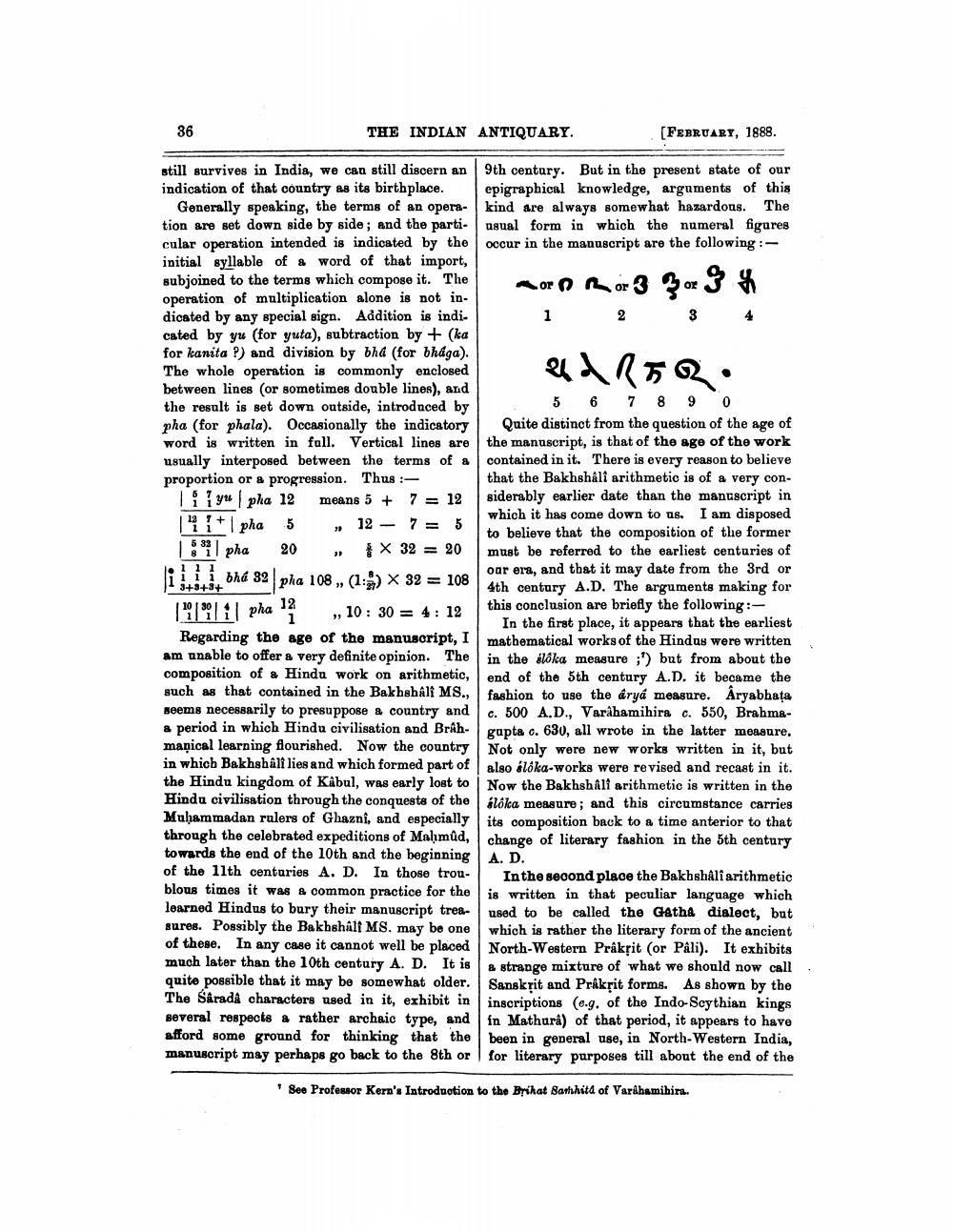________________
36
still survives in India, we can still discern an indication of that country as its birthplace.
Generally speaking, the terms of an operation are set down side by side; and the particular operation intended is indicated by the initial syllable of a word of that import, subjoined to the terms which compose it. The operation of multiplication alone is not indicated by any special sign. Addition is indicated by yu (for yuta), subtraction by + (ka for kanita ?) and division by bhá (for bhága). The whole operation is commonly enclosed between lines (or sometimes double lines), and the result is set down outside, introduced by pha (for phala). Occasionally the indicatory word is written in full. Vertical lines are usually interposed between the terms of a proportion or a progression. Thus :means 5+ 7 = 12 12 - 7 = 5 X 32 = 20
ypha 12 pha 1
5 20
bhá 32 pha 108,, (1) X 32
13 7+
533 | pha
8
1 1 1 3+3+3+
12 1
18 مام |||||
22
""
THE INDIAN ANTIQUARY.
95
108
10 30 4: 12
Regarding the age of the manuscript, I am unable to offer a very definite opinion. The composition of a Hindu work on arithmetic, such as that contained in the Bakhshâli MS., seems necessarily to presuppose a country and a period in which Hindu civilisation and Brâhmanical learning flourished. Now the country in which Bakhshâli lies and which formed part of the Hindu kingdom of Kâbul, was early lost to Hindu civilisation through the conquests of the Muhammadan rulers of Ghazni, and especially through the celebrated expeditions of Mahmûd, towards the end of the 10th and the beginning of the 11th centuries A. D. In those troublous times it was a common practice for the learned Hindus to bury their manuscript treasures. Possibly the Bakhshalt MS. may be one of these. In any case it cannot well be placed much later than the 10th century A. D. It is quite possible that it may be somewhat older. The Sarada characters used in it, exhibit in several respects a rather archaic type, and afford some ground for thinking that the manuscript may perhaps go back to the 8th or
[FEBRUARY, 1888.
9th century. But in the present state of our epigraphical knowledge, arguments of this kind are always somewhat hazardous. The usual form in which the numeral figures occur in the manuscript are the following:
or
1
34 $
no3 3o.
or
or
2
3
adRxQ.
5 6 7 8 9 0 Quite distinct from the question of the age of the manuscript, is that of the age of the work contained in it. There is every reason to believe that the Bakhshâlî arithmetic is of a very considerably earlier date than the manuscript in which it has come down to us. I am disposed to believe that the composition of the former must be referred to the earliest centuries of our era, and that it may date from the 3rd or 4th century A.D. The arguments making for this conclusion are briefly the following:
In the first place, it appears that the earliest mathematical works of the Hindus were written in the sloka measure ;') but from about the end of the 5th century A.D. it became the fashion to use the dryá measure. Aryabhata c. 500 A.D., Varâhamihira c. 550, Brahmagupta c. 630, all wrote in the latter measure. Not only were new works written in it, but also álóka-works were revised and recast in it. Now the Bakhshall arithmetic is written in the sloka measure; and this circumstance carries its composition back to a time anterior to that change of literary fashion in the 5th century A. D.
In the second place the Bakhshâlî arithmetic is written in that peculiar language which used to be called the Gatha dialect, but which is rather the literary form of the ancient North-Western Prâkrit (or Pâli). It exhibits a strange mixture of what we should now call Sanskrit and Prakrit forms. As shown by the inscriptions (e.g. of the Indo-Scythian kings in Mathura) of that period, it appears to have been in general use, in North-Western India, for literary purposes till about the end of the
* See Professor Kern's Introduction to the Brihat Samhita of Varahamihira.




